Supply Chain Analytics Coursework Report: Barilla Case Study Analysis
VerifiedAdded on 2023/01/11
|11
|3094
|47
Report
AI Summary
This report presents an analysis of a supply chain analytics coursework, focusing on a case study of Barilla's durum wheat supply chain contracts. The coursework explores the contract structures, objectives, and the contracting process, including the use of value contracts with incomplete certainty. The research design includes objectives, data collection methods, and findings from semi-structured interviews. The discussion of findings highlights the benefits of these contracts for Barilla and its suppliers, including welfare, quality improvement, and risk mitigation. The report also examines the motivations behind the contracts, the social components involved, and the evolution of the contracts over time. Furthermore, the report delves into how Barilla's contracts address various office issues and use assessment tools. The conclusions emphasize the link between legally binding elements and chain stability, sustainable supply chain management, and the main triple benefits achieved through the use of graceful contracts. The report contributes to the understanding of sustainable supply chain management and offers insights for agri-food administrators.
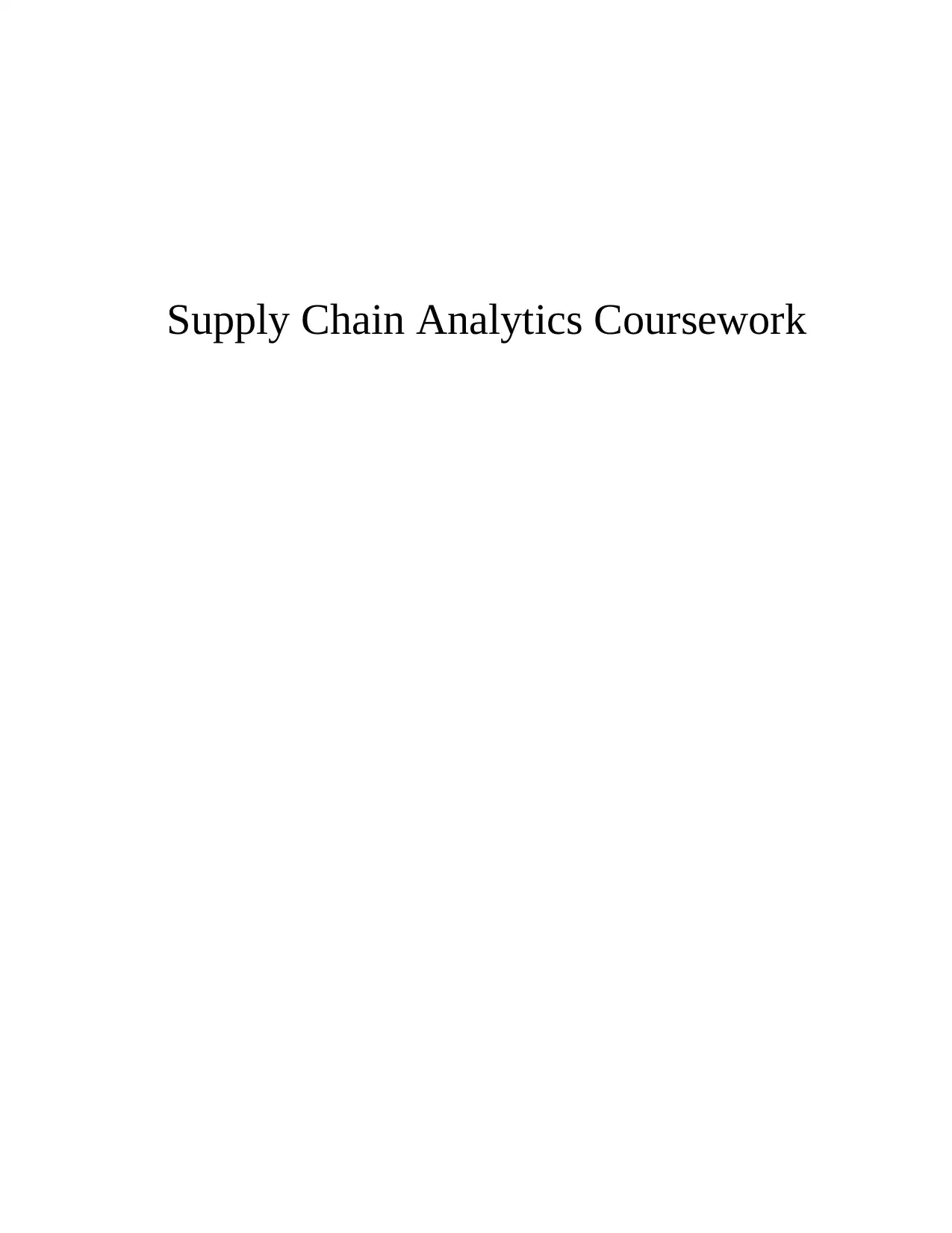
Supply Chain Analytics Coursework
Paraphrase This Document
Need a fresh take? Get an instant paraphrase of this document with our AI Paraphraser
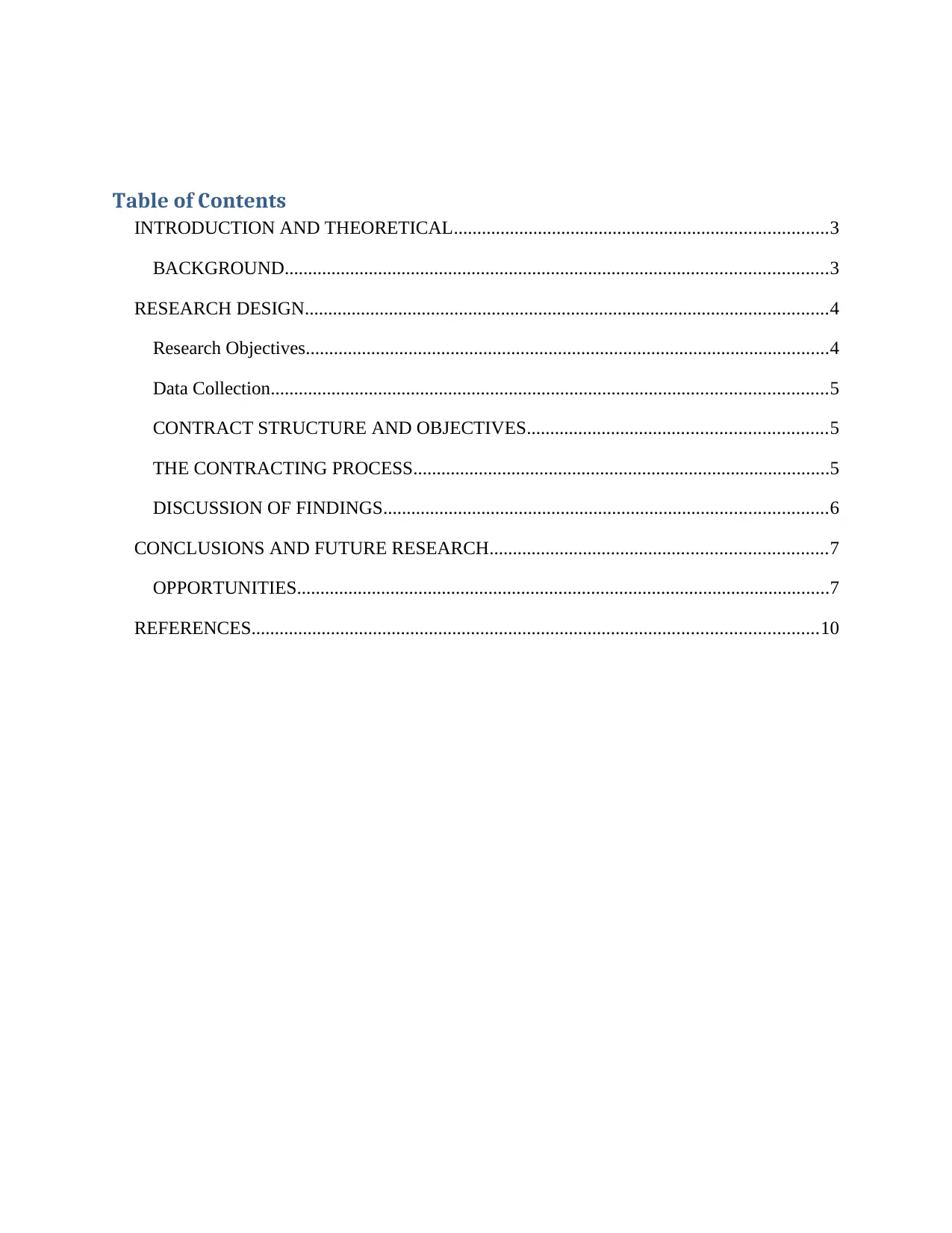
Table of Contents
INTRODUCTION AND THEORETICAL................................................................................3
BACKGROUND....................................................................................................................3
RESEARCH DESIGN................................................................................................................4
Research Objectives................................................................................................................4
Data Collection.......................................................................................................................5
CONTRACT STRUCTURE AND OBJECTIVES................................................................5
THE CONTRACTING PROCESS.........................................................................................5
DISCUSSION OF FINDINGS...............................................................................................6
CONCLUSIONS AND FUTURE RESEARCH........................................................................7
OPPORTUNITIES..................................................................................................................7
REFERENCES.........................................................................................................................10
INTRODUCTION AND THEORETICAL................................................................................3
BACKGROUND....................................................................................................................3
RESEARCH DESIGN................................................................................................................4
Research Objectives................................................................................................................4
Data Collection.......................................................................................................................5
CONTRACT STRUCTURE AND OBJECTIVES................................................................5
THE CONTRACTING PROCESS.........................................................................................5
DISCUSSION OF FINDINGS...............................................................................................6
CONCLUSIONS AND FUTURE RESEARCH........................................................................7
OPPORTUNITIES..................................................................................................................7
REFERENCES.........................................................................................................................10
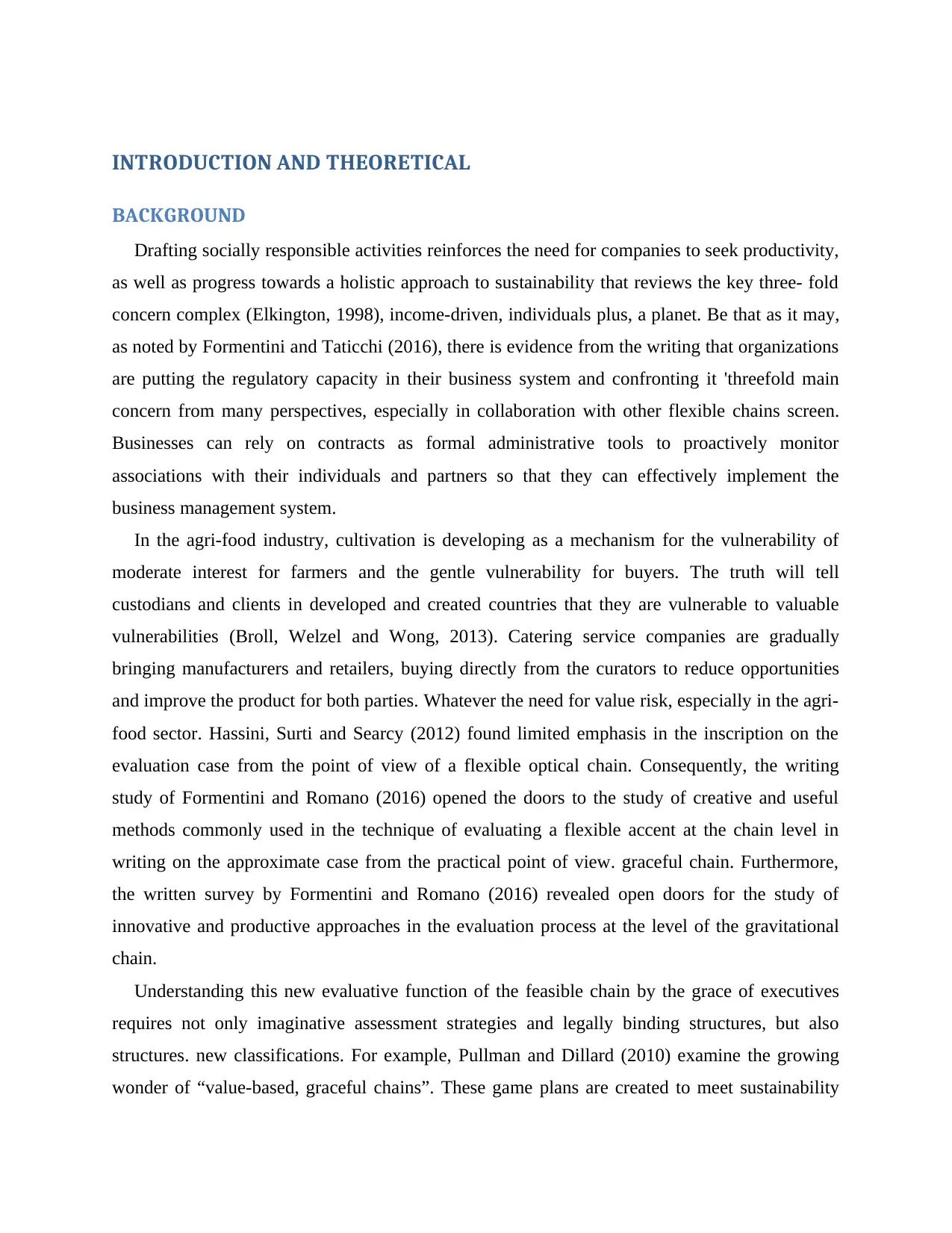
INTRODUCTION AND THEORETICAL
BACKGROUND
Drafting socially responsible activities reinforces the need for companies to seek productivity,
as well as progress towards a holistic approach to sustainability that reviews the key three- fold
concern complex (Elkington, 1998), income-driven, individuals plus, a planet. Be that as it may,
as noted by Formentini and Taticchi (2016), there is evidence from the writing that organizations
are putting the regulatory capacity in their business system and confronting it 'threefold main
concern from many perspectives, especially in collaboration with other flexible chains screen.
Businesses can rely on contracts as formal administrative tools to proactively monitor
associations with their individuals and partners so that they can effectively implement the
business management system.
In the agri-food industry, cultivation is developing as a mechanism for the vulnerability of
moderate interest for farmers and the gentle vulnerability for buyers. The truth will tell
custodians and clients in developed and created countries that they are vulnerable to valuable
vulnerabilities (Broll, Welzel and Wong, 2013). Catering service companies are gradually
bringing manufacturers and retailers, buying directly from the curators to reduce opportunities
and improve the product for both parties. Whatever the need for value risk, especially in the agri-
food sector. Hassini, Surti and Searcy (2012) found limited emphasis in the inscription on the
evaluation case from the point of view of a flexible optical chain. Consequently, the writing
study of Formentini and Romano (2016) opened the doors to the study of creative and useful
methods commonly used in the technique of evaluating a flexible accent at the chain level in
writing on the approximate case from the practical point of view. graceful chain. Furthermore,
the written survey by Formentini and Romano (2016) revealed open doors for the study of
innovative and productive approaches in the evaluation process at the level of the gravitational
chain.
Understanding this new evaluative function of the feasible chain by the grace of executives
requires not only imaginative assessment strategies and legally binding structures, but also
structures. new classifications. For example, Pullman and Dillard (2010) examine the growing
wonder of “value-based, graceful chains”. These game plans are created to meet sustainability
BACKGROUND
Drafting socially responsible activities reinforces the need for companies to seek productivity,
as well as progress towards a holistic approach to sustainability that reviews the key three- fold
concern complex (Elkington, 1998), income-driven, individuals plus, a planet. Be that as it may,
as noted by Formentini and Taticchi (2016), there is evidence from the writing that organizations
are putting the regulatory capacity in their business system and confronting it 'threefold main
concern from many perspectives, especially in collaboration with other flexible chains screen.
Businesses can rely on contracts as formal administrative tools to proactively monitor
associations with their individuals and partners so that they can effectively implement the
business management system.
In the agri-food industry, cultivation is developing as a mechanism for the vulnerability of
moderate interest for farmers and the gentle vulnerability for buyers. The truth will tell
custodians and clients in developed and created countries that they are vulnerable to valuable
vulnerabilities (Broll, Welzel and Wong, 2013). Catering service companies are gradually
bringing manufacturers and retailers, buying directly from the curators to reduce opportunities
and improve the product for both parties. Whatever the need for value risk, especially in the agri-
food sector. Hassini, Surti and Searcy (2012) found limited emphasis in the inscription on the
evaluation case from the point of view of a flexible optical chain. Consequently, the writing
study of Formentini and Romano (2016) opened the doors to the study of creative and useful
methods commonly used in the technique of evaluating a flexible accent at the chain level in
writing on the approximate case from the practical point of view. graceful chain. Furthermore,
the written survey by Formentini and Romano (2016) revealed open doors for the study of
innovative and productive approaches in the evaluation process at the level of the gravitational
chain.
Understanding this new evaluative function of the feasible chain by the grace of executives
requires not only imaginative assessment strategies and legally binding structures, but also
structures. new classifications. For example, Pullman and Dillard (2010) examine the growing
wonder of “value-based, graceful chains”. These game plans are created to meet sustainability
⊘ This is a preview!⊘
Do you want full access?
Subscribe today to unlock all pages.

Trusted by 1+ million students worldwide
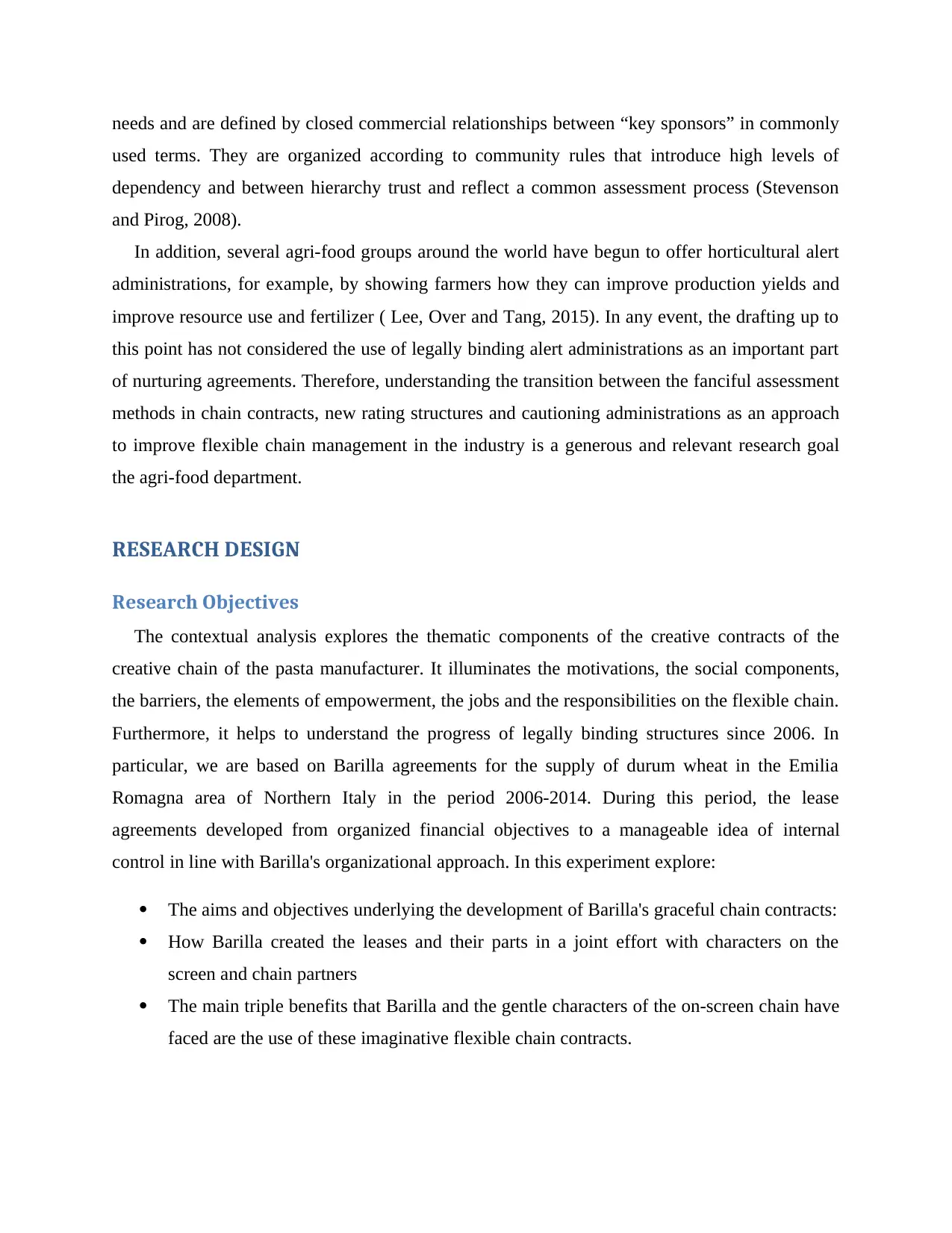
needs and are defined by closed commercial relationships between “key sponsors” in commonly
used terms. They are organized according to community rules that introduce high levels of
dependency and between hierarchy trust and reflect a common assessment process (Stevenson
and Pirog, 2008).
In addition, several agri-food groups around the world have begun to offer horticultural alert
administrations, for example, by showing farmers how they can improve production yields and
improve resource use and fertilizer ( Lee, Over and Tang, 2015). In any event, the drafting up to
this point has not considered the use of legally binding alert administrations as an important part
of nurturing agreements. Therefore, understanding the transition between the fanciful assessment
methods in chain contracts, new rating structures and cautioning administrations as an approach
to improve flexible chain management in the industry is a generous and relevant research goal
the agri-food department.
RESEARCH DESIGN
Research Objectives
The contextual analysis explores the thematic components of the creative contracts of the
creative chain of the pasta manufacturer. It illuminates the motivations, the social components,
the barriers, the elements of empowerment, the jobs and the responsibilities on the flexible chain.
Furthermore, it helps to understand the progress of legally binding structures since 2006. In
particular, we are based on Barilla agreements for the supply of durum wheat in the Emilia
Romagna area of Northern Italy in the period 2006-2014. During this period, the lease
agreements developed from organized financial objectives to a manageable idea of internal
control in line with Barilla's organizational approach. In this experiment explore:
The aims and objectives underlying the development of Barilla's graceful chain contracts:
How Barilla created the leases and their parts in a joint effort with characters on the
screen and chain partners
The main triple benefits that Barilla and the gentle characters of the on-screen chain have
faced are the use of these imaginative flexible chain contracts.
used terms. They are organized according to community rules that introduce high levels of
dependency and between hierarchy trust and reflect a common assessment process (Stevenson
and Pirog, 2008).
In addition, several agri-food groups around the world have begun to offer horticultural alert
administrations, for example, by showing farmers how they can improve production yields and
improve resource use and fertilizer ( Lee, Over and Tang, 2015). In any event, the drafting up to
this point has not considered the use of legally binding alert administrations as an important part
of nurturing agreements. Therefore, understanding the transition between the fanciful assessment
methods in chain contracts, new rating structures and cautioning administrations as an approach
to improve flexible chain management in the industry is a generous and relevant research goal
the agri-food department.
RESEARCH DESIGN
Research Objectives
The contextual analysis explores the thematic components of the creative contracts of the
creative chain of the pasta manufacturer. It illuminates the motivations, the social components,
the barriers, the elements of empowerment, the jobs and the responsibilities on the flexible chain.
Furthermore, it helps to understand the progress of legally binding structures since 2006. In
particular, we are based on Barilla agreements for the supply of durum wheat in the Emilia
Romagna area of Northern Italy in the period 2006-2014. During this period, the lease
agreements developed from organized financial objectives to a manageable idea of internal
control in line with Barilla's organizational approach. In this experiment explore:
The aims and objectives underlying the development of Barilla's graceful chain contracts:
How Barilla created the leases and their parts in a joint effort with characters on the
screen and chain partners
The main triple benefits that Barilla and the gentle characters of the on-screen chain have
faced are the use of these imaginative flexible chain contracts.
Paraphrase This Document
Need a fresh take? Get an instant paraphrase of this document with our AI Paraphraser
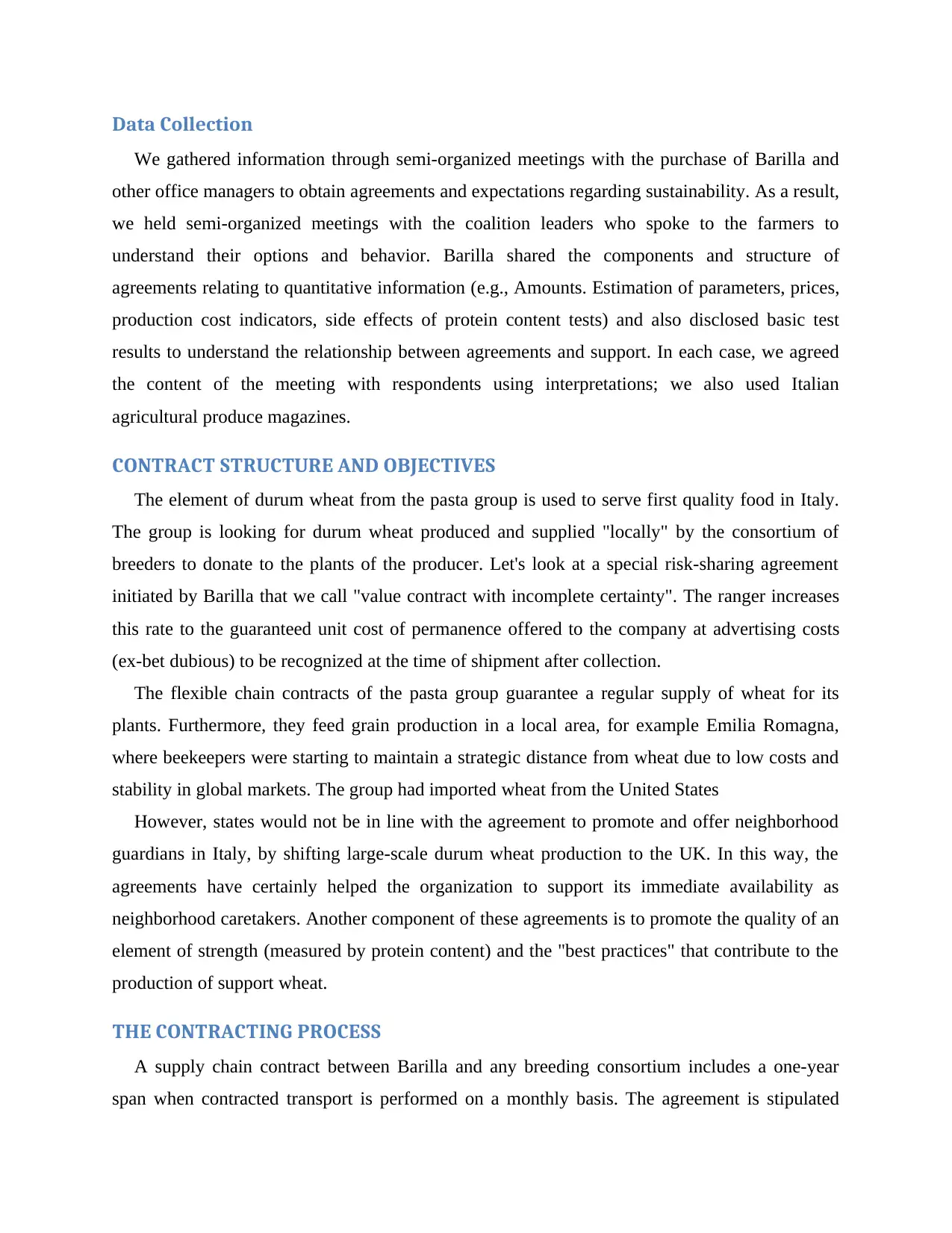
Data Collection
We gathered information through semi-organized meetings with the purchase of Barilla and
other office managers to obtain agreements and expectations regarding sustainability. As a result,
we held semi-organized meetings with the coalition leaders who spoke to the farmers to
understand their options and behavior. Barilla shared the components and structure of
agreements relating to quantitative information (e.g., Amounts. Estimation of parameters, prices,
production cost indicators, side effects of protein content tests) and also disclosed basic test
results to understand the relationship between agreements and support. In each case, we agreed
the content of the meeting with respondents using interpretations; we also used Italian
agricultural produce magazines.
CONTRACT STRUCTURE AND OBJECTIVES
The element of durum wheat from the pasta group is used to serve first quality food in Italy.
The group is looking for durum wheat produced and supplied "locally" by the consortium of
breeders to donate to the plants of the producer. Let's look at a special risk-sharing agreement
initiated by Barilla that we call "value contract with incomplete certainty". The ranger increases
this rate to the guaranteed unit cost of permanence offered to the company at advertising costs
(ex-bet dubious) to be recognized at the time of shipment after collection.
The flexible chain contracts of the pasta group guarantee a regular supply of wheat for its
plants. Furthermore, they feed grain production in a local area, for example Emilia Romagna,
where beekeepers were starting to maintain a strategic distance from wheat due to low costs and
stability in global markets. The group had imported wheat from the United States
However, states would not be in line with the agreement to promote and offer neighborhood
guardians in Italy, by shifting large-scale durum wheat production to the UK. In this way, the
agreements have certainly helped the organization to support its immediate availability as
neighborhood caretakers. Another component of these agreements is to promote the quality of an
element of strength (measured by protein content) and the "best practices" that contribute to the
production of support wheat.
THE CONTRACTING PROCESS
A supply chain contract between Barilla and any breeding consortium includes a one-year
span when contracted transport is performed on a monthly basis. The agreement is stipulated
We gathered information through semi-organized meetings with the purchase of Barilla and
other office managers to obtain agreements and expectations regarding sustainability. As a result,
we held semi-organized meetings with the coalition leaders who spoke to the farmers to
understand their options and behavior. Barilla shared the components and structure of
agreements relating to quantitative information (e.g., Amounts. Estimation of parameters, prices,
production cost indicators, side effects of protein content tests) and also disclosed basic test
results to understand the relationship between agreements and support. In each case, we agreed
the content of the meeting with respondents using interpretations; we also used Italian
agricultural produce magazines.
CONTRACT STRUCTURE AND OBJECTIVES
The element of durum wheat from the pasta group is used to serve first quality food in Italy.
The group is looking for durum wheat produced and supplied "locally" by the consortium of
breeders to donate to the plants of the producer. Let's look at a special risk-sharing agreement
initiated by Barilla that we call "value contract with incomplete certainty". The ranger increases
this rate to the guaranteed unit cost of permanence offered to the company at advertising costs
(ex-bet dubious) to be recognized at the time of shipment after collection.
The flexible chain contracts of the pasta group guarantee a regular supply of wheat for its
plants. Furthermore, they feed grain production in a local area, for example Emilia Romagna,
where beekeepers were starting to maintain a strategic distance from wheat due to low costs and
stability in global markets. The group had imported wheat from the United States
However, states would not be in line with the agreement to promote and offer neighborhood
guardians in Italy, by shifting large-scale durum wheat production to the UK. In this way, the
agreements have certainly helped the organization to support its immediate availability as
neighborhood caretakers. Another component of these agreements is to promote the quality of an
element of strength (measured by protein content) and the "best practices" that contribute to the
production of support wheat.
THE CONTRACTING PROCESS
A supply chain contract between Barilla and any breeding consortium includes a one-year
span when contracted transport is performed on a monthly basis. The agreement is stipulated
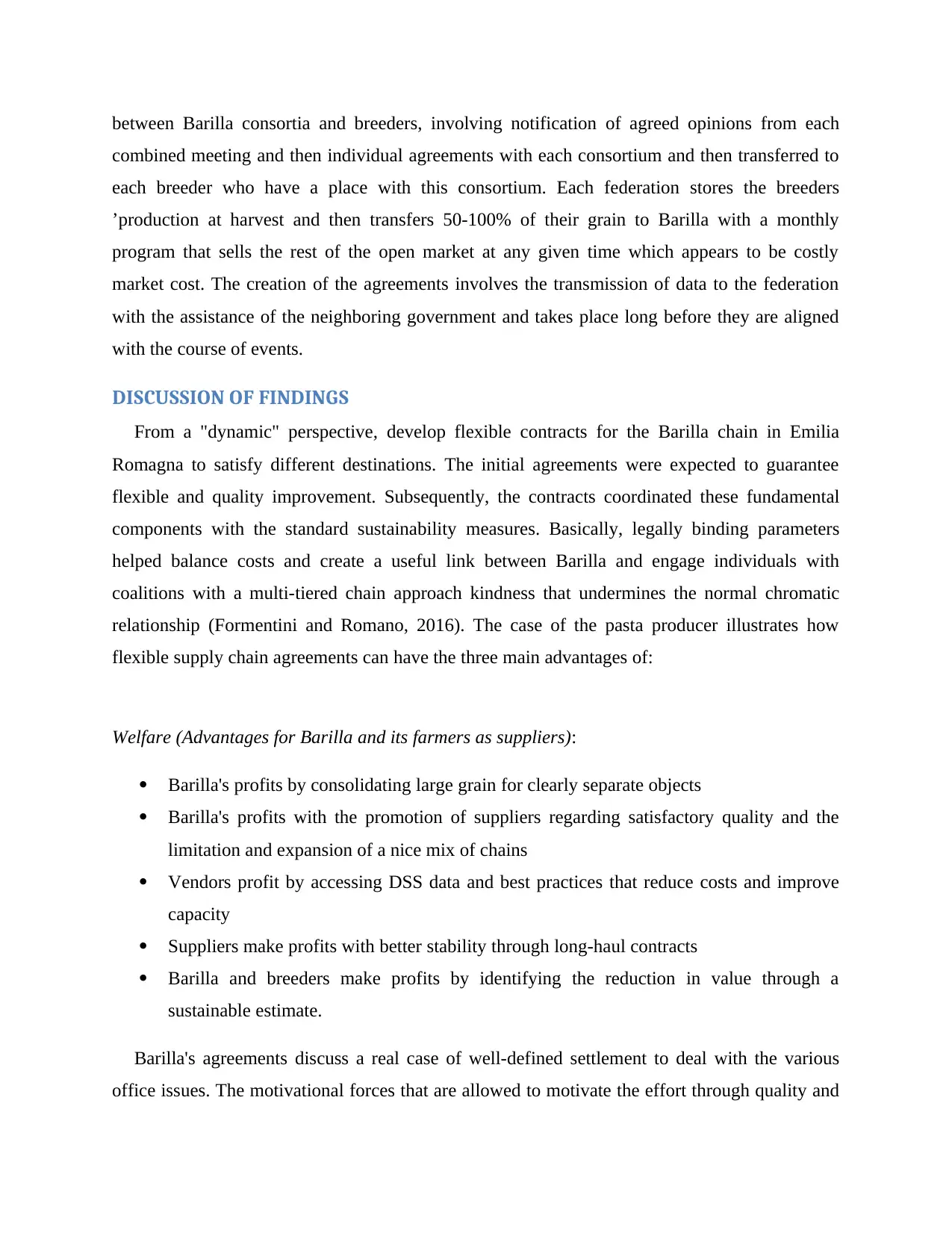
between Barilla consortia and breeders, involving notification of agreed opinions from each
combined meeting and then individual agreements with each consortium and then transferred to
each breeder who have a place with this consortium. Each federation stores the breeders
’production at harvest and then transfers 50-100% of their grain to Barilla with a monthly
program that sells the rest of the open market at any given time which appears to be costly
market cost. The creation of the agreements involves the transmission of data to the federation
with the assistance of the neighboring government and takes place long before they are aligned
with the course of events.
DISCUSSION OF FINDINGS
From a "dynamic" perspective, develop flexible contracts for the Barilla chain in Emilia
Romagna to satisfy different destinations. The initial agreements were expected to guarantee
flexible and quality improvement. Subsequently, the contracts coordinated these fundamental
components with the standard sustainability measures. Basically, legally binding parameters
helped balance costs and create a useful link between Barilla and engage individuals with
coalitions with a multi-tiered chain approach kindness that undermines the normal chromatic
relationship (Formentini and Romano, 2016). The case of the pasta producer illustrates how
flexible supply chain agreements can have the three main advantages of:
Welfare (Advantages for Barilla and its farmers as suppliers):
Barilla's profits by consolidating large grain for clearly separate objects
Barilla's profits with the promotion of suppliers regarding satisfactory quality and the
limitation and expansion of a nice mix of chains
Vendors profit by accessing DSS data and best practices that reduce costs and improve
capacity
Suppliers make profits with better stability through long-haul contracts
Barilla and breeders make profits by identifying the reduction in value through a
sustainable estimate.
Barilla's agreements discuss a real case of well-defined settlement to deal with the various
office issues. The motivational forces that are allowed to motivate the effort through quality and
combined meeting and then individual agreements with each consortium and then transferred to
each breeder who have a place with this consortium. Each federation stores the breeders
’production at harvest and then transfers 50-100% of their grain to Barilla with a monthly
program that sells the rest of the open market at any given time which appears to be costly
market cost. The creation of the agreements involves the transmission of data to the federation
with the assistance of the neighboring government and takes place long before they are aligned
with the course of events.
DISCUSSION OF FINDINGS
From a "dynamic" perspective, develop flexible contracts for the Barilla chain in Emilia
Romagna to satisfy different destinations. The initial agreements were expected to guarantee
flexible and quality improvement. Subsequently, the contracts coordinated these fundamental
components with the standard sustainability measures. Basically, legally binding parameters
helped balance costs and create a useful link between Barilla and engage individuals with
coalitions with a multi-tiered chain approach kindness that undermines the normal chromatic
relationship (Formentini and Romano, 2016). The case of the pasta producer illustrates how
flexible supply chain agreements can have the three main advantages of:
Welfare (Advantages for Barilla and its farmers as suppliers):
Barilla's profits by consolidating large grain for clearly separate objects
Barilla's profits with the promotion of suppliers regarding satisfactory quality and the
limitation and expansion of a nice mix of chains
Vendors profit by accessing DSS data and best practices that reduce costs and improve
capacity
Suppliers make profits with better stability through long-haul contracts
Barilla and breeders make profits by identifying the reduction in value through a
sustainable estimate.
Barilla's agreements discuss a real case of well-defined settlement to deal with the various
office issues. The motivational forces that are allowed to motivate the effort through quality and
⊘ This is a preview!⊘
Do you want full access?
Subscribe today to unlock all pages.

Trusted by 1+ million students worldwide
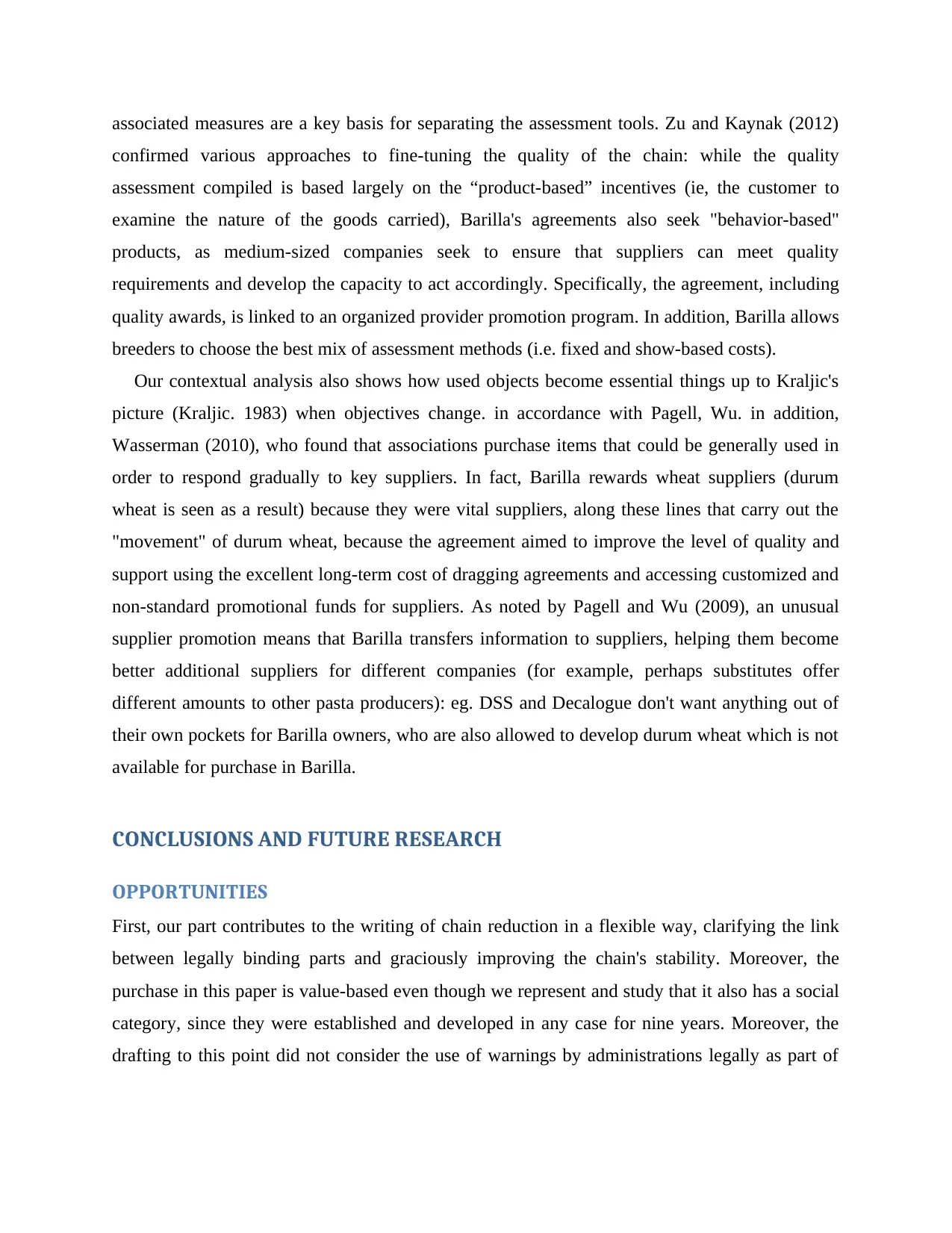
associated measures are a key basis for separating the assessment tools. Zu and Kaynak (2012)
confirmed various approaches to fine-tuning the quality of the chain: while the quality
assessment compiled is based largely on the “product-based” incentives (ie, the customer to
examine the nature of the goods carried), Barilla's agreements also seek "behavior-based"
products, as medium-sized companies seek to ensure that suppliers can meet quality
requirements and develop the capacity to act accordingly. Specifically, the agreement, including
quality awards, is linked to an organized provider promotion program. In addition, Barilla allows
breeders to choose the best mix of assessment methods (i.e. fixed and show-based costs).
Our contextual analysis also shows how used objects become essential things up to Kraljic's
picture (Kraljic. 1983) when objectives change. in accordance with Pagell, Wu. in addition,
Wasserman (2010), who found that associations purchase items that could be generally used in
order to respond gradually to key suppliers. In fact, Barilla rewards wheat suppliers (durum
wheat is seen as a result) because they were vital suppliers, along these lines that carry out the
"movement" of durum wheat, because the agreement aimed to improve the level of quality and
support using the excellent long-term cost of dragging agreements and accessing customized and
non-standard promotional funds for suppliers. As noted by Pagell and Wu (2009), an unusual
supplier promotion means that Barilla transfers information to suppliers, helping them become
better additional suppliers for different companies (for example, perhaps substitutes offer
different amounts to other pasta producers): eg. DSS and Decalogue don't want anything out of
their own pockets for Barilla owners, who are also allowed to develop durum wheat which is not
available for purchase in Barilla.
CONCLUSIONS AND FUTURE RESEARCH
OPPORTUNITIES
First, our part contributes to the writing of chain reduction in a flexible way, clarifying the link
between legally binding parts and graciously improving the chain's stability. Moreover, the
purchase in this paper is value-based even though we represent and study that it also has a social
category, since they were established and developed in any case for nine years. Moreover, the
drafting to this point did not consider the use of warnings by administrations legally as part of
confirmed various approaches to fine-tuning the quality of the chain: while the quality
assessment compiled is based largely on the “product-based” incentives (ie, the customer to
examine the nature of the goods carried), Barilla's agreements also seek "behavior-based"
products, as medium-sized companies seek to ensure that suppliers can meet quality
requirements and develop the capacity to act accordingly. Specifically, the agreement, including
quality awards, is linked to an organized provider promotion program. In addition, Barilla allows
breeders to choose the best mix of assessment methods (i.e. fixed and show-based costs).
Our contextual analysis also shows how used objects become essential things up to Kraljic's
picture (Kraljic. 1983) when objectives change. in accordance with Pagell, Wu. in addition,
Wasserman (2010), who found that associations purchase items that could be generally used in
order to respond gradually to key suppliers. In fact, Barilla rewards wheat suppliers (durum
wheat is seen as a result) because they were vital suppliers, along these lines that carry out the
"movement" of durum wheat, because the agreement aimed to improve the level of quality and
support using the excellent long-term cost of dragging agreements and accessing customized and
non-standard promotional funds for suppliers. As noted by Pagell and Wu (2009), an unusual
supplier promotion means that Barilla transfers information to suppliers, helping them become
better additional suppliers for different companies (for example, perhaps substitutes offer
different amounts to other pasta producers): eg. DSS and Decalogue don't want anything out of
their own pockets for Barilla owners, who are also allowed to develop durum wheat which is not
available for purchase in Barilla.
CONCLUSIONS AND FUTURE RESEARCH
OPPORTUNITIES
First, our part contributes to the writing of chain reduction in a flexible way, clarifying the link
between legally binding parts and graciously improving the chain's stability. Moreover, the
purchase in this paper is value-based even though we represent and study that it also has a social
category, since they were established and developed in any case for nine years. Moreover, the
drafting to this point did not consider the use of warnings by administrations legally as part of
Paraphrase This Document
Need a fresh take? Get an instant paraphrase of this document with our AI Paraphraser
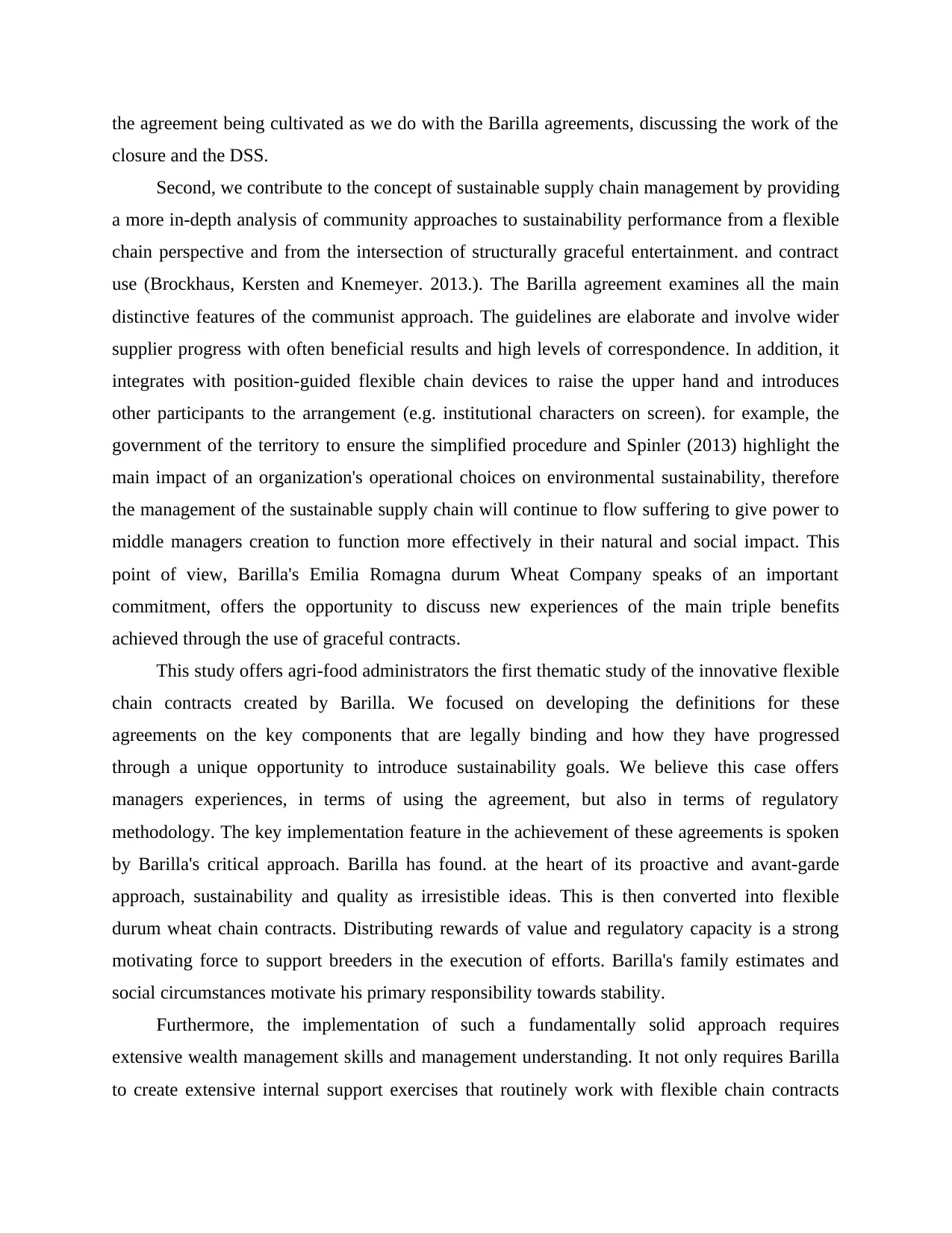
the agreement being cultivated as we do with the Barilla agreements, discussing the work of the
closure and the DSS.
Second, we contribute to the concept of sustainable supply chain management by providing
a more in-depth analysis of community approaches to sustainability performance from a flexible
chain perspective and from the intersection of structurally graceful entertainment. and contract
use (Brockhaus, Kersten and Knemeyer. 2013.). The Barilla agreement examines all the main
distinctive features of the communist approach. The guidelines are elaborate and involve wider
supplier progress with often beneficial results and high levels of correspondence. In addition, it
integrates with position-guided flexible chain devices to raise the upper hand and introduces
other participants to the arrangement (e.g. institutional characters on screen). for example, the
government of the territory to ensure the simplified procedure and Spinler (2013) highlight the
main impact of an organization's operational choices on environmental sustainability, therefore
the management of the sustainable supply chain will continue to flow suffering to give power to
middle managers creation to function more effectively in their natural and social impact. This
point of view, Barilla's Emilia Romagna durum Wheat Company speaks of an important
commitment, offers the opportunity to discuss new experiences of the main triple benefits
achieved through the use of graceful contracts.
This study offers agri-food administrators the first thematic study of the innovative flexible
chain contracts created by Barilla. We focused on developing the definitions for these
agreements on the key components that are legally binding and how they have progressed
through a unique opportunity to introduce sustainability goals. We believe this case offers
managers experiences, in terms of using the agreement, but also in terms of regulatory
methodology. The key implementation feature in the achievement of these agreements is spoken
by Barilla's critical approach. Barilla has found. at the heart of its proactive and avant-garde
approach, sustainability and quality as irresistible ideas. This is then converted into flexible
durum wheat chain contracts. Distributing rewards of value and regulatory capacity is a strong
motivating force to support breeders in the execution of efforts. Barilla's family estimates and
social circumstances motivate his primary responsibility towards stability.
Furthermore, the implementation of such a fundamentally solid approach requires
extensive wealth management skills and management understanding. It not only requires Barilla
to create extensive internal support exercises that routinely work with flexible chain contracts
closure and the DSS.
Second, we contribute to the concept of sustainable supply chain management by providing
a more in-depth analysis of community approaches to sustainability performance from a flexible
chain perspective and from the intersection of structurally graceful entertainment. and contract
use (Brockhaus, Kersten and Knemeyer. 2013.). The Barilla agreement examines all the main
distinctive features of the communist approach. The guidelines are elaborate and involve wider
supplier progress with often beneficial results and high levels of correspondence. In addition, it
integrates with position-guided flexible chain devices to raise the upper hand and introduces
other participants to the arrangement (e.g. institutional characters on screen). for example, the
government of the territory to ensure the simplified procedure and Spinler (2013) highlight the
main impact of an organization's operational choices on environmental sustainability, therefore
the management of the sustainable supply chain will continue to flow suffering to give power to
middle managers creation to function more effectively in their natural and social impact. This
point of view, Barilla's Emilia Romagna durum Wheat Company speaks of an important
commitment, offers the opportunity to discuss new experiences of the main triple benefits
achieved through the use of graceful contracts.
This study offers agri-food administrators the first thematic study of the innovative flexible
chain contracts created by Barilla. We focused on developing the definitions for these
agreements on the key components that are legally binding and how they have progressed
through a unique opportunity to introduce sustainability goals. We believe this case offers
managers experiences, in terms of using the agreement, but also in terms of regulatory
methodology. The key implementation feature in the achievement of these agreements is spoken
by Barilla's critical approach. Barilla has found. at the heart of its proactive and avant-garde
approach, sustainability and quality as irresistible ideas. This is then converted into flexible
durum wheat chain contracts. Distributing rewards of value and regulatory capacity is a strong
motivating force to support breeders in the execution of efforts. Barilla's family estimates and
social circumstances motivate his primary responsibility towards stability.
Furthermore, the implementation of such a fundamentally solid approach requires
extensive wealth management skills and management understanding. It not only requires Barilla
to create extensive internal support exercises that routinely work with flexible chain contracts
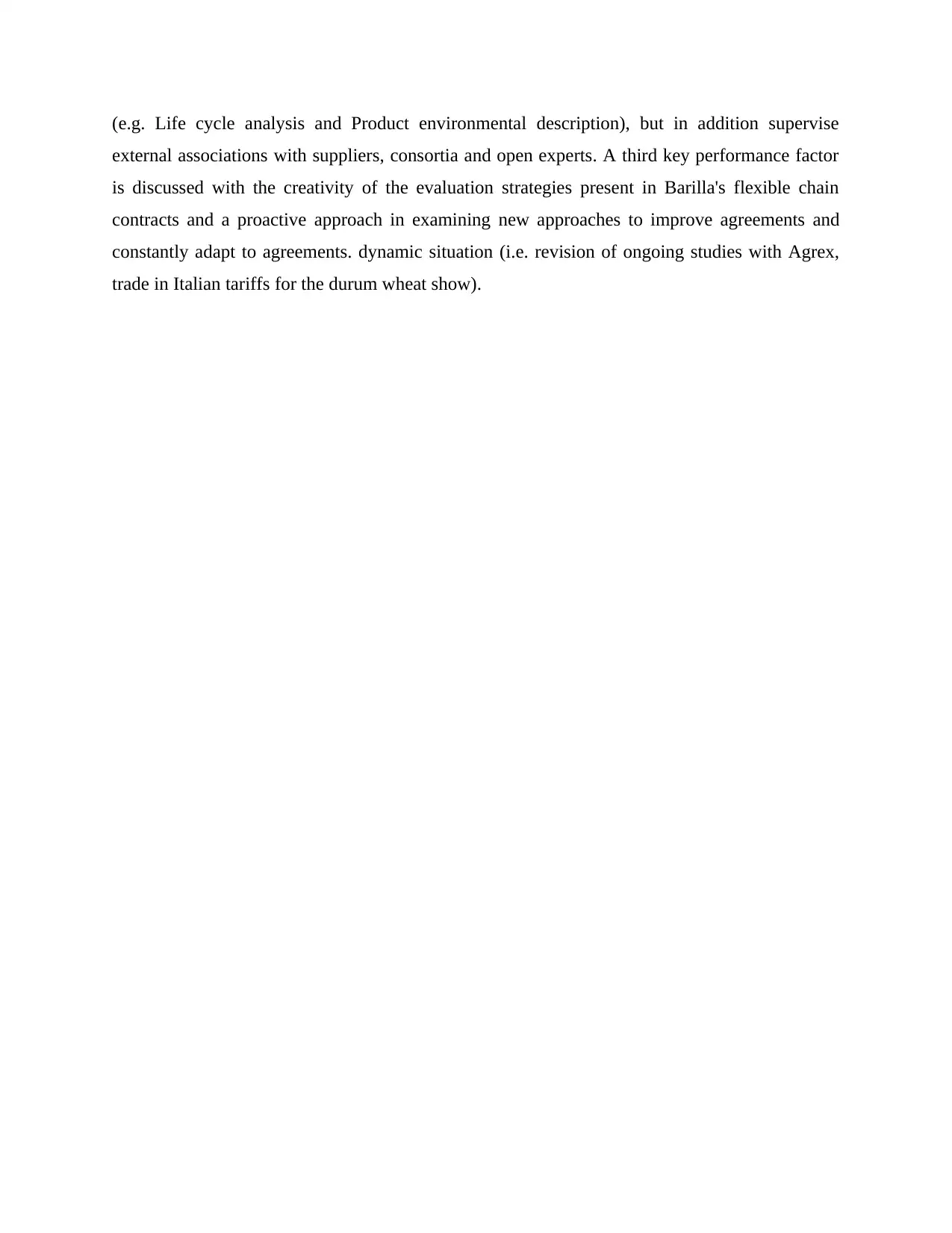
(e.g. Life cycle analysis and Product environmental description), but in addition supervise
external associations with suppliers, consortia and open experts. A third key performance factor
is discussed with the creativity of the evaluation strategies present in Barilla's flexible chain
contracts and a proactive approach in examining new approaches to improve agreements and
constantly adapt to agreements. dynamic situation (i.e. revision of ongoing studies with Agrex,
trade in Italian tariffs for the durum wheat show).
external associations with suppliers, consortia and open experts. A third key performance factor
is discussed with the creativity of the evaluation strategies present in Barilla's flexible chain
contracts and a proactive approach in examining new approaches to improve agreements and
constantly adapt to agreements. dynamic situation (i.e. revision of ongoing studies with Agrex,
trade in Italian tariffs for the durum wheat show).
⊘ This is a preview!⊘
Do you want full access?
Subscribe today to unlock all pages.

Trusted by 1+ million students worldwide
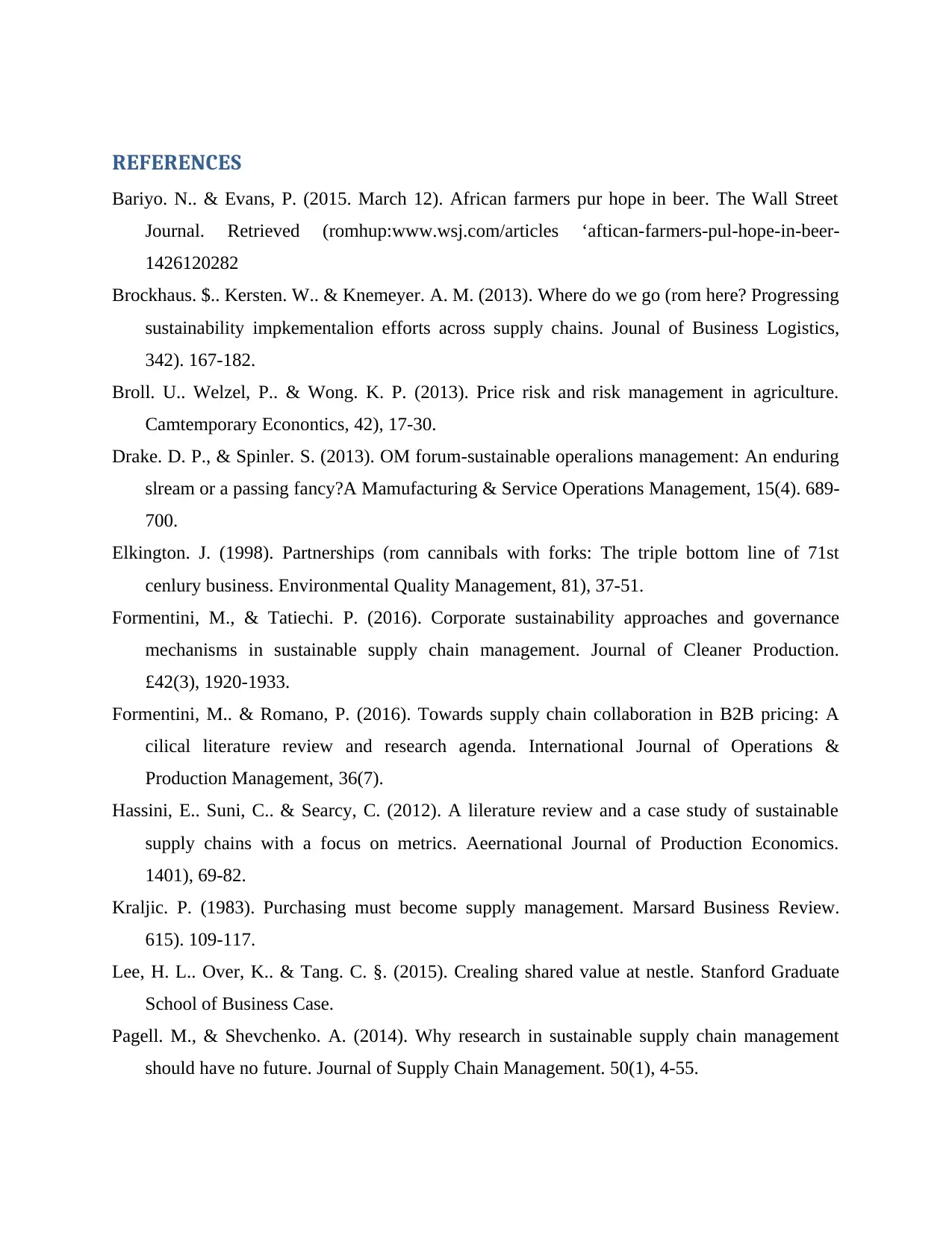
REFERENCES
Bariyo. N.. & Evans, P. (2015. March 12). African farmers pur hope in beer. The Wall Street
Journal. Retrieved (romhup:www.wsj.com/articles ‘aftican-farmers-pul-hope-in-beer-
1426120282
Brockhaus. $.. Kersten. W.. & Knemeyer. A. M. (2013). Where do we go (rom here? Progressing
sustainability impkementalion efforts across supply chains. Jounal of Business Logistics,
342). 167-182.
Broll. U.. Welzel, P.. & Wong. K. P. (2013). Price risk and risk management in agriculture.
Camtemporary Econontics, 42), 17-30.
Drake. D. P., & Spinler. S. (2013). OM forum-sustainable operalions management: An enduring
slream or a passing fancy?A Mamufacturing & Service Operations Management, 15(4). 689-
700.
Elkington. J. (1998). Partnerships (rom cannibals with forks: The triple bottom line of 71st
cenlury business. Environmental Quality Management, 81), 37-51.
Formentini, M., & Tatiechi. P. (2016). Corporate sustainability approaches and governance
mechanisms in sustainable supply chain management. Journal of Cleaner Production.
£42(3), 1920-1933.
Formentini, M.. & Romano, P. (2016). Towards supply chain collaboration in B2B pricing: A
cilical literature review and research agenda. International Journal of Operations &
Production Management, 36(7).
Hassini, E.. Suni, C.. & Searcy, C. (2012). A lilerature review and a case study of sustainable
supply chains with a focus on metrics. Aeernational Journal of Production Economics.
1401), 69-82.
Kraljic. P. (1983). Purchasing must become supply management. Marsard Business Review.
615). 109-117.
Lee, H. L.. Over, K.. & Tang. C. §. (2015). Crealing shared value at nestle. Stanford Graduate
School of Business Case.
Pagell. M., & Shevchenko. A. (2014). Why research in sustainable supply chain management
should have no future. Journal of Supply Chain Management. 50(1), 4-55.
Bariyo. N.. & Evans, P. (2015. March 12). African farmers pur hope in beer. The Wall Street
Journal. Retrieved (romhup:www.wsj.com/articles ‘aftican-farmers-pul-hope-in-beer-
1426120282
Brockhaus. $.. Kersten. W.. & Knemeyer. A. M. (2013). Where do we go (rom here? Progressing
sustainability impkementalion efforts across supply chains. Jounal of Business Logistics,
342). 167-182.
Broll. U.. Welzel, P.. & Wong. K. P. (2013). Price risk and risk management in agriculture.
Camtemporary Econontics, 42), 17-30.
Drake. D. P., & Spinler. S. (2013). OM forum-sustainable operalions management: An enduring
slream or a passing fancy?A Mamufacturing & Service Operations Management, 15(4). 689-
700.
Elkington. J. (1998). Partnerships (rom cannibals with forks: The triple bottom line of 71st
cenlury business. Environmental Quality Management, 81), 37-51.
Formentini, M., & Tatiechi. P. (2016). Corporate sustainability approaches and governance
mechanisms in sustainable supply chain management. Journal of Cleaner Production.
£42(3), 1920-1933.
Formentini, M.. & Romano, P. (2016). Towards supply chain collaboration in B2B pricing: A
cilical literature review and research agenda. International Journal of Operations &
Production Management, 36(7).
Hassini, E.. Suni, C.. & Searcy, C. (2012). A lilerature review and a case study of sustainable
supply chains with a focus on metrics. Aeernational Journal of Production Economics.
1401), 69-82.
Kraljic. P. (1983). Purchasing must become supply management. Marsard Business Review.
615). 109-117.
Lee, H. L.. Over, K.. & Tang. C. §. (2015). Crealing shared value at nestle. Stanford Graduate
School of Business Case.
Pagell. M., & Shevchenko. A. (2014). Why research in sustainable supply chain management
should have no future. Journal of Supply Chain Management. 50(1), 4-55.
Paraphrase This Document
Need a fresh take? Get an instant paraphrase of this document with our AI Paraphraser
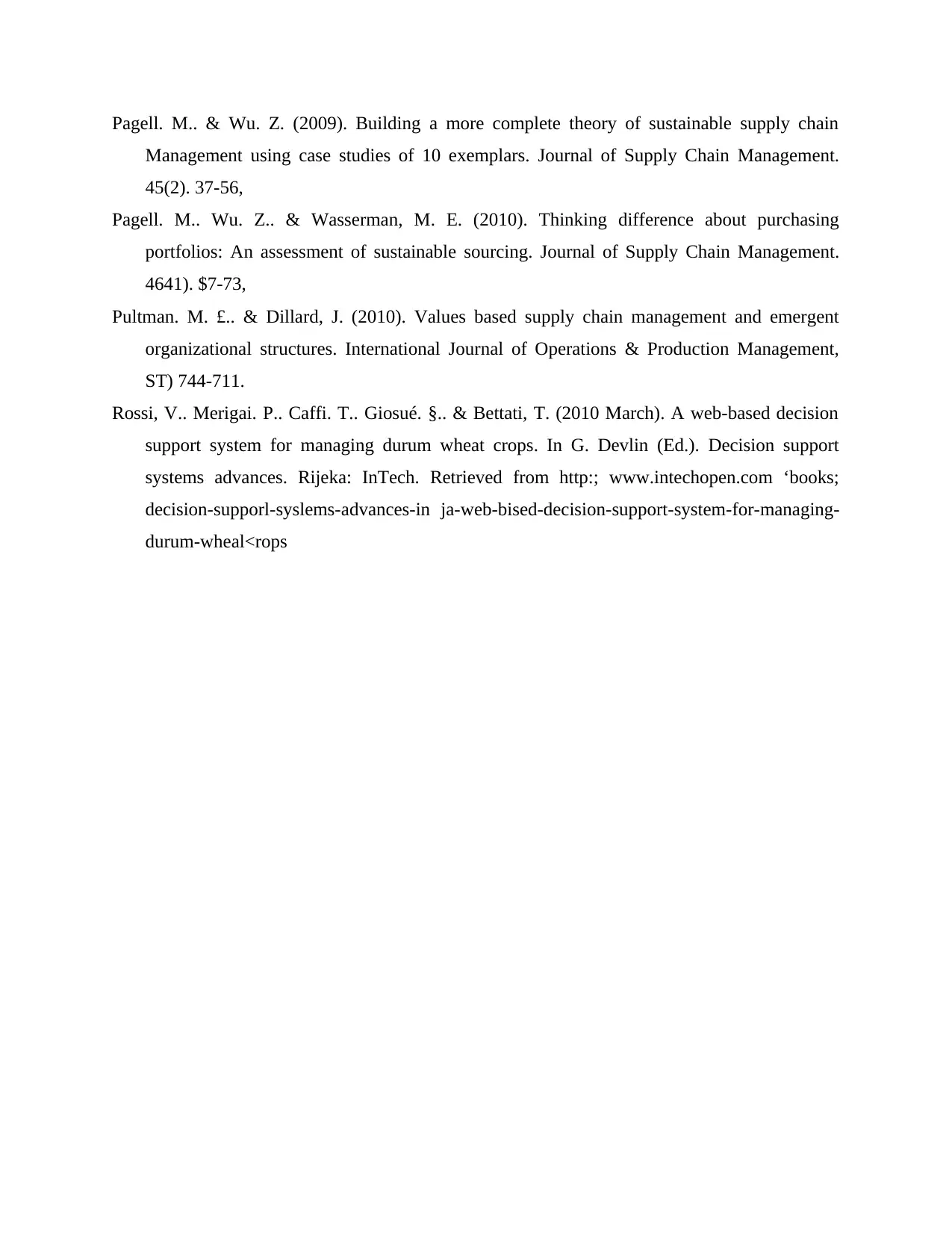
Pagell. M.. & Wu. Z. (2009). Building a more complete theory of sustainable supply chain
Management using case studies of 10 exemplars. Journal of Supply Chain Management.
45(2). 37-56,
Pagell. M.. Wu. Z.. & Wasserman, M. E. (2010). Thinking difference about purchasing
portfolios: An assessment of sustainable sourcing. Journal of Supply Chain Management.
4641). $7-73,
Pultman. M. £.. & Dillard, J. (2010). Values based supply chain management and emergent
organizational structures. International Journal of Operations & Production Management,
ST) 744-711.
Rossi, V.. Merigai. P.. Caffi. T.. Giosué. §.. & Bettati, T. (2010 March). A web-based decision
support system for managing durum wheat crops. In G. Devlin (Ed.). Decision support
systems advances. Rijeka: InTech. Retrieved from http:; www.intechopen.com ‘books;
decision-supporl-syslems-advances-in ja-web-bised-decision-support-system-for-managing-
durum-wheal<rops
Management using case studies of 10 exemplars. Journal of Supply Chain Management.
45(2). 37-56,
Pagell. M.. Wu. Z.. & Wasserman, M. E. (2010). Thinking difference about purchasing
portfolios: An assessment of sustainable sourcing. Journal of Supply Chain Management.
4641). $7-73,
Pultman. M. £.. & Dillard, J. (2010). Values based supply chain management and emergent
organizational structures. International Journal of Operations & Production Management,
ST) 744-711.
Rossi, V.. Merigai. P.. Caffi. T.. Giosué. §.. & Bettati, T. (2010 March). A web-based decision
support system for managing durum wheat crops. In G. Devlin (Ed.). Decision support
systems advances. Rijeka: InTech. Retrieved from http:; www.intechopen.com ‘books;
decision-supporl-syslems-advances-in ja-web-bised-decision-support-system-for-managing-
durum-wheal<rops
1 out of 11
Your All-in-One AI-Powered Toolkit for Academic Success.
+13062052269
info@desklib.com
Available 24*7 on WhatsApp / Email
![[object Object]](/_next/static/media/star-bottom.7253800d.svg)
Unlock your academic potential
Copyright © 2020–2025 A2Z Services. All Rights Reserved. Developed and managed by ZUCOL.